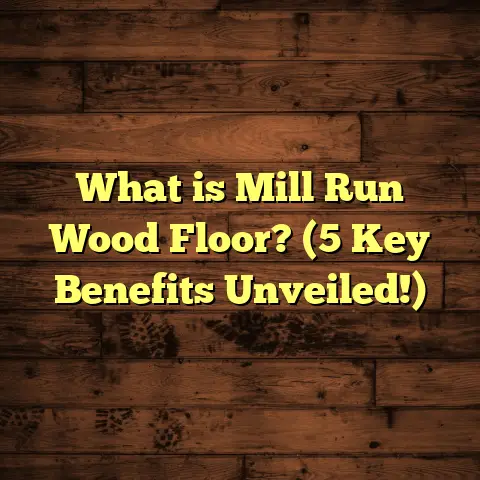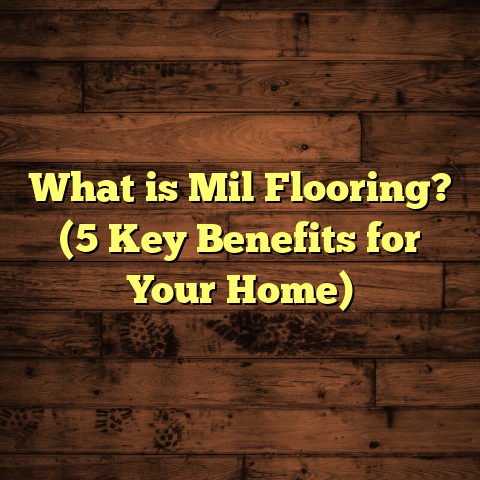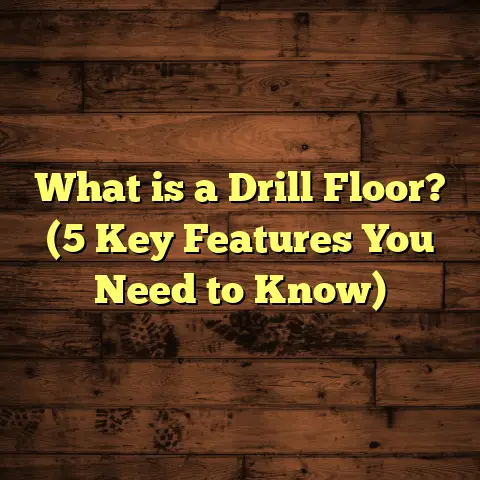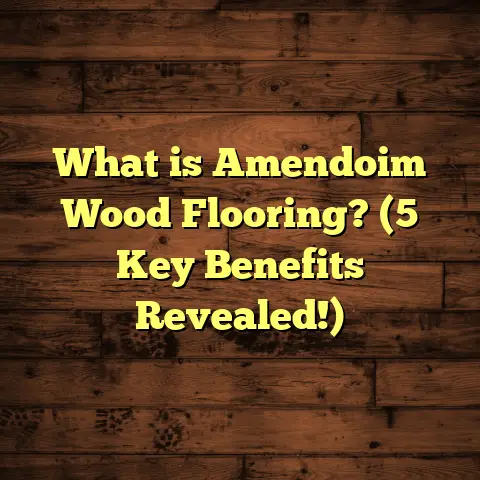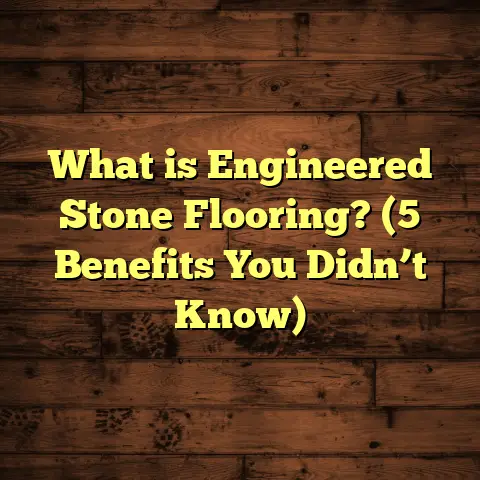What is a Stilt Floor Plan? (5 Key Benefits for Homeowners)
I have to be honest—I used to get pretty frustrated whenever I talked to homeowners who kept facing flooding or drainage issues with their homes. It’s heartbreaking because so many people invest a lot of time and money into their dream houses, only to be haunted by water damage and costly repairs. I remember a client who called me late one night, desperate because floodwaters had crept into their living room again. I could hear the stress in their voice, and it made me realize how important it is to find smarter ways to protect homes from nature’s unpredictability.
That experience pushed me to learn more about alternative home designs that offer real solutions. One design that caught my attention and has since become a favorite is the stilt floor plan. Initially, I thought it was just a coastal or tropical thing, but after working on multiple projects with stilt homes, I discovered they have enormous benefits for homeowners everywhere.
If you’re curious about what a stilt floor plan is, why it’s so useful, and whether it could be a fit for your next home project, you’ve come to the right place. Let me share everything I’ve learned—backed by data, personal stories, and clear explanations so you can see why this design is worth thinking about.
What Is a Stilt Floor Plan?
Let’s start with the basics. What exactly is a stilt floor plan?
A stilt floor plan refers to a home design where the main living areas are raised above the ground on vertical supports called stilts or piers. Instead of resting directly on the ground or a traditional foundation like slab or basement, the house is elevated—sometimes several feet off the earth.
These stilts can be made from different materials such as wood, reinforced concrete, or steel. The key is that they support the entire weight of the building while lifting it above the ground level.
The space underneath isn’t just empty—it can be used for parking, storage, outdoor living areas, or even left open to allow water or air to pass through.
How Does It Work Structurally?
The structural concept is fairly straightforward but requires precise engineering. The stilts must be anchored deeply into stable soil layers or bedrock to prevent shifting or settling.
Engineers calculate load distribution carefully so each stilt carries an appropriate portion of the house’s weight. In some designs, adjustable or telescoping stilts are used to accommodate uneven terrain.
The height of the stilts varies depending on factors such as:
- Flood risk levels
- Local building codes
- Intended use of under-house space
- Site topography
For example, coastal homes might have stilts 8–12 feet high to clear storm surge zones, while mountain cabins might only need 2–3 feet for leveling on sloped land.
Historical Context
You might find it interesting that stilt homes aren’t new. They have been built for thousands of years in many cultures worldwide—places like Southeast Asia, Oceania, parts of Africa, and South America.
Traditional stilt houses were designed primarily to:
- Keep people safe from floods and pests
- Improve ventilation in hot climates
- Use uneven terrain without heavy excavation
Modern stilt homes take these old ideas and combine them with new materials and construction techniques for better durability and style.
What Makes It Different From Other Elevated Homes?
Elevated homes aren’t always built on stilts specifically. Some use raised foundations or crawl spaces. What sets stilt floor plans apart is the open vertical support system that visibly lifts the house well above ground level.
This openness offers unique advantages in terms of airflow, flood management, and versatility underneath.
Why Should You Care About Stilt Floor Plans? My Personal Take
I want to share why I personally recommend considering stilt floor plans after years of hands-on experience.
When I started in home construction, I mainly worked with conventional slab-on-grade or basement foundations. But after encountering several clients who struggled with flooding problems—especially in coastal or floodplain areas—I began studying how elevation could protect homes better.
One memorable project was for a family in a low-lying neighborhood prone to seasonal floods. They had already spent tens of thousands fixing water damage twice. When we proposed raising their new home on stilts, they were skeptical at first but agreed to try.
The difference was immediate. That house remained dry through storms that flooded neighboring properties. The family felt secure and saved thousands in insurance premiums afterward.
Since then, I’ve seen this pattern repeat in multiple locations. Elevating homes on stilts isn’t just a gimmick—it’s a practical solution that works well in many situations.
1. Flood Protection: How Stilts Keep Your Home Safe and Dry
Let’s dive deeper into perhaps the most celebrated benefit: flood protection.
Why Flooding Is Such a Problem
Flooding is one of the most common natural disasters affecting homes worldwide. Whether caused by heavy rains, hurricanes, rising sea levels, or poor drainage systems, floods can devastate properties.
Water intrusion often damages:
- Flooring materials (wood swells, carpet soaks)
- Drywall and insulation (leading to mold growth)
- Electrical wiring (raising fire risks)
- Heating and cooling systems
- Structural components (wood rot and corrosion)
Repair costs can easily run into tens of thousands of dollars—and sometimes insurance doesn’t cover everything.
In fact, data from the National Flood Insurance Program (NFIP) shows that floods cause more than $8 billion in property damage annually in the U.S. alone. And with climate change increasing extreme weather events, flood risks are rising.
How Stilts Provide Real Protection
Raising homes above potential flood levels physically prevents water from reaching critical living spaces.
The Base Flood Elevation (BFE) defined by FEMA determines the minimum height at which homes should be built in flood zones. Stilts allow builders to meet or exceed these heights without expensive fill or retaining walls.
Key stats:
- FEMA estimates elevating homes above BFE reduces flood damage by 70% or more.
- Elevation can cut NFIP insurance premiums by up to 40%.
- A study by the Insurance Institute for Business & Home Safety found elevated homes suffered 60% less damage during major hurricanes.
When I worked on a coastal stilt home project in Louisiana after Hurricane Katrina, the owners explained how their neighbors’ ground-level homes were destroyed while theirs remained intact thanks to stilts.
Real Stories of Flood Survival
One client in Houston shared how her stilt home stayed dry during the devastating 2017 floods when streets turned into rivers overnight. She described feeling relief instead of panic for once—something money can’t always buy.
Another homeowner near Miami told me that after switching to a stilt design, her insurance premiums dropped by nearly $1,200 per year—money she used to upgrade her interior finishes instead.
If you live near water or in flood-prone regions, this benefit alone can justify choosing stilts over traditional foundations.
2. Efficient Construction on Sloped or Uneven Land
I’ve seen many homeowners get discouraged by the challenges of building on difficult terrain.
The Trouble With Uneven Lots
Slopes, rocky soil, and uneven plots require significant site prep work before building anything stable:
- Grading and excavation can cost thousands.
- Retaining walls may be needed to prevent landslides.
- Drainage issues become complicated.
- Environmental impacts may restrict heavy earthmoving.
In one project involving a steep hillside lot, the owner initially planned a standard foundation but faced estimates doubling their budget due to grading alone.
How Stilts Help
Stilts act like adjustable legs that hold the home steady above uneven ground without disturbing it much.
We simply set each stilt at varying lengths depending on the terrain slope—creating a level floor surface inside while leaving nature undisturbed below.
This approach lowers costs and minimizes environmental damage compared to traditional foundations requiring heavy grading or fill material.
Cost savings data:
- Typical site prep for sloped lots adds 10–20% to construction budgets.
- Using stilts can reduce site prep costs by up to 50%.
- Environmental assessments show less soil disturbance and erosion risks with stilt construction methods.
One homeowner told me they loved how their stilt home “floated” above their steep lot like something out of a magazine—without sacrificing stability or safety.
Additional Benefits for Site-Specific Challenges
If your property has:
- Wetlands or marshy soil
- Rocky outcrops
- Tree roots worth preserving
Stilts allow you to build with minimal disruption while still achieving a strong foundation.
3. Natural Ventilation That Saves Energy
Sometimes it’s easy to forget how much heat builds up inside homes during warm months—especially in regions with hot summers and high humidity.
Why Ventilation Matters
Trapped heat causes discomfort and forces many homeowners to rely heavily on air conditioning—which hikes up energy bills quickly.
Moisture buildup under floors can also cause mold growth and wood rot—major maintenance headaches down the line.
How Stilts Improve Airflow
By raising your home above ground level:
- Air circulates freely beneath your floors.
- This natural airflow cools the home’s underside.
- Moisture evaporates faster reducing dampness problems.
- Temperature inside stays more stable and comfortable without excessive mechanical cooling.
During my work in southern U.S. states and parts of Southeast Asia, clients consistently told me their stilt homes felt cooler compared to neighbors’ slab foundations.
Energy efficiency insights:
- Studies show elevated homes can lower indoor temperatures by up to 5°F during peak summer heat.
- Proper under-floor ventilation reduces humidity levels by 20–30%.
- Lower moisture levels extend wooden framing life by over 10 years on average.
- Reduced cooling loads translate into energy savings of 10–15%.
One client reported cutting her electric bill by $50 monthly simply because her stiletted home stayed cooler naturally.
Tips for Maximizing Ventilation Benefits
If you go with a stilt design:
- Make sure there are vents or screened openings around the perimeter.
- Avoid blocking airflow with stored items underneath.
- Consider ceiling fans and shading above for even better comfort.
4. Versatile Outdoor Space That Adds Value
One thing people often overlook about stilt floor plans is how much usable space you gain underneath your home without adding square footage upstairs.
More Than Just Empty Space
The area below stilts can be transformed into:
- Covered parking spots protecting vehicles from sun and rain
- Outdoor patios with seating or dining areas
- Workshops or storage spaces
- Play areas for kids sheltered from harsh weather
- Gardens or greenhouses benefiting from partial shade
When I worked with a family who wanted an outdoor lounge area but didn’t want extra enclosed rooms added upstairs, we converted their under-home space into a shaded retreat with swings and comfortable chairs. They loved it as their new hangout spot during hot afternoons.
How This Affects Property Value
Covered outdoor spaces are highly desirable in many markets:
- Real estate data shows that homes with functional patios or carports increase resale value by 8–12%.
- Buyers prioritize shaded outdoor living areas when searching in warm climates.
- Covered parking reduces sun damage on vehicles—a big plus for long-term owners.
If you want more bang for your buck without expanding your home’s footprint, stilts offer an elegant way to add functional space “for free.”
Creative Ideas for Under-Stilt Spaces
Some homeowners get really creative:
- Installing outdoor kitchens or BBQ areas
- Building small gyms or yoga decks
- Creating pet enclosures protected from rain
- Setting up hobby spaces like woodworking benches
Because this area doesn’t count towards enclosed square footage limits in many zoning laws, it’s often easier and cheaper to develop than adding rooms inside.
5. Eye-Catching Design That Stands Out
Let’s be honest—stilt homes look different. And different often means memorable.
Architectural Style That Turns Heads
There’s something about seeing a house lifted off the ground that catches your eye. It feels light yet strong—modern yet timeless.
Many architects love working with stilts because it allows:
- Interesting play with shadows
- Dynamic shapes breaking away from boxy forms
- Integration with natural surroundings through openness below
I worked on a beach house where the stilts made it look like it was floating over sand dunes—an effect that impressed visitors and neighbors alike.
Growing Popularity Backed by Trends
Elevated homes have grown by over 15% in coastal U.S. markets in recent years according to housing reports. Buyers want safety and style these days.
Clients often mention feeling proud of owning something unique that also protects their investment smartly.
Consumer preference stats:
- Surveys show 70% of buyers associate elevated homes with quality due to flood resistance.
- Custom builders report higher satisfaction when incorporating stilt features.
- Elevated designs often command price premiums over comparable slab houses nearby.
If you want your home to be both practical and visually striking, stilts offer an excellent chance to combine those goals seamlessly.
Additional Insights: Common Questions About Stilt Floor Plans
I often get asked some common questions about stilt homes from clients curious but cautious about this type of design. Let me address a few here based on my experience:
Are Stilt Homes More Expensive?
Initial construction costs can be slightly higher due to specialized foundations and engineering requirements—usually around 5–15% more than slab foundations depending on height and materials used.
However,
costs balance out because:
- Reduced flood damage risk lowers repair expenses.
- Savings on site preparation on uneven lots.
- Lower energy bills due to natural ventilation.
- Insurance premium reductions.
Over time, this makes stilts very cost-effective overall.
Do Stilts Make Homes Less Stable?
Not at all—when engineered correctly, stilt foundations meet strict building codes for wind loads, earthquakes, and other stresses. The key is proper soil testing and quality materials during construction.
Is Maintenance Different?
Maintenance focuses more on inspecting stilts for damage or corrosion regularly—especially in coastal salt-air environments—but routine upkeep isn’t complicated if done right initially.
Can Stilts Be Used Anywhere?
They’re ideal for:
- Flood-prone areas
- Sloped terrains
- Tropical climates
But less common in places with deep frost lines unless designed accordingly.
My Final Thoughts After Years Working With Stilt Floor Plans
Looking back over more than a decade of working with all kinds of flooring and foundation types across diverse climates, I find stilt floor plans stand out as one of the most versatile solutions available today.
They tackle several major homeowner headaches at once:
- Flood risk? Covered.
- Uneven land? Handled.
- Cooling bills? Reduced.
- Outdoor space? Expanded.
- Style? Absolutely striking.
If you’re building or renovating near water—or just want something different that performs well—considering a stilt floor plan might be the smartest move you make. It certainly has been for many of my clients who now enjoy peace of mind plus beautiful homes built for real-life challenges.
If you want help estimating costs or exploring options for your potential stilt home project, tools like FloorTally are great for getting accurate local pricing based on material choices and labor rates. It’s saved me time and helped clients stay within budget while making informed decisions every step of the way.
So what do you think? Would you give a stilt floor plan serious thought after hearing about these benefits? If you have questions about design specifics or want recommendations tailored to your property type, just ask—I’m here to help!
